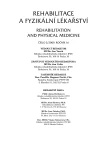Craniosacral Stabilization
Authors:
M. Jendrichovský
Authors‘ workplace:
LF UPJŠ a FN L. Pasteura, Klinika FBLR, Košice
prednosta kliniky doc. P. Takáč, Ph. D.
Published in:
Rehabil. fyz. Lék., 16, 2009, No. 2, pp. 79-84.
Category:
Original Papers
Overview
This review article deals with the arresting function of deep stabilization system, whose kinetic effect participates in adoption of neutral position in the joint i.e. position which requires minimum activity of muscles participating in postural function. The given fixation is executed on the basis of muscular coactivation of the deep stabilization system with muscular layers positioned more to the body surface. The dynamic search for stability is based and is directed to maintaining optimal postural adjustment and coordinated movement of the spine and extremities in the three dimensional space. The first system of originating dysfunction appears to be the change of tension in different layers. The deeper layers of arresting components respond more intensively to changes in tension associated with vital functions and maintenance of posture, whereas the more superficial positioned myofascial complex apparently adopts a greater kinetic effect.
Key words:
stability, dynamic balance, craniosacral maintenance, neutral joint position, tonus gradient
Sources
1. CYRIAX, J.: Textbook of ortopaedic medicine: diagnosis of soft tissue lesions. London Bailliere Tindal, 1, 1982.
2. ČUMPELÍK, J., VÉLE, F. et al.: Vztah medzi dechovými pohyby a držením tela. Rehabil. fyz. Lék., 2006, 2, s. 62-70.
3. HERMACH, C. M. H.: Proč je rotace trupu tak zranitelná? Konference „Kineziológie 2004“ , Praha, 23.-24. 6. 2004. In: Rehabil. fyz. Lék., 2004, č. 4, s. 197-203.
4. HERTLING, D., KESSLER, R. M.: Management of common Musculoskeletal disorders – Physical therapy principles and methods. Philadelphia, Lippincot Williams&Wilkins, 2006, ISBN 0-7817-3626-9.
5. JIROUT, J.: Persistence of sinkinetic patterns of cervical spine. In: Lewit K.: Manipulační léčba v myoskeletální medicíne. Sdělovací technika, Praha, 2003, 5. Přepracované vydání, ISBN 80-86645-04-5.
6. KOLÁŘ, P.: Vertebrogénní obtíže a stabilizační funkce páteře – terapie. Rehabil. fyz. Lék., 2007, č. 1, s. 3-17.
7. JENDRICHOVSKÝ, M., TAKÁČ, P.: Význam mäkkých častí pri vzniku sakroiliakálnych dysfunkcií u poúrazových stavov dolných končatín. Rehabil. fyz. Lék., 13, 2006, č. 1, s. 24-28.
8. LÁNIK, V.: Kineziológia. Vyd. 1., Martin, Osveta, 1990, ISBN 80-217-0136-6.
9. LEWIT, K.: Vztah struktury a funkce v pohybové soustavě. Rehabil. fyz. Lék., 2000, č. 3, s. 99-101.
10. LEWIT, K.: Manipulační léčba v myoskeletální medicíne. Sdělovací technika, Praha, 2003. 5. přepracované vydání, ISBN 80-86645-04-5.
11. LEWIT, K.: Rehabilitace u bolestivých poruch pohybové soustavy. Rehabil. fyz. Lék., 2001, č. 1, s. 4-17.
12. MENNELL, J.: Joint pain. Boston, Little and Co., 1964.
13. MLODINOW, L.: Euklidovo okno. Slovart, Praha, 2007, ISBN 978-80-7209-900-9.
14. NORRIS, C.: Back stability. Champaign: Human Kinetics, 2000.
15. PANJABI, M. M.: The stabilizing system of spine: Part II. Neutral zone and instability hypothesis. Journal of Spinal Disorders, 1992, č. 5, s. 390-397.
16. PENZIAS, A.: Como vivere in un mundo High-Tech. Miláno, Bompiani, 1989, s. 107-108.
17. SUCHOMEL, T.: Stabilita v pohybovém systému a hluboký stabilizační systém – podstata a klinické východiska. Rehabil. fyz. Lék., 2006, č. 3, s. 112-124.
18. VÉLE, F., ČUMPELÍK, J., PAVLŮ, D.: Úvaha nad problémem „stability“ ve fyzioterapii. Rehabil. fyz. Lék., 2004, č. 3, s. 103-105.
19. VÉLE, F.: Kineziológie pro klinickou praxi. 1. vydanie. Grada, Praha, 1997, ISBN 80-7169-256-5.
Labels
Physiotherapist, university degree Rehabilitation Sports medicineArticle was published in
Rehabilitation & Physical Medicine

2009 Issue 2
Most read in this issue
- How to Work with ICF (International Classification of Functional Abilities, Disability and Health)
- Parsis of n. facialis in Patients after CMP and its Effect on Orofacial Functions
- The Problems of Corset Application in Juvenile Idiopathic Scoliosis
- Fibromyalgia 2009 – Where, How and Why Physical Therapy Can be Helpful
